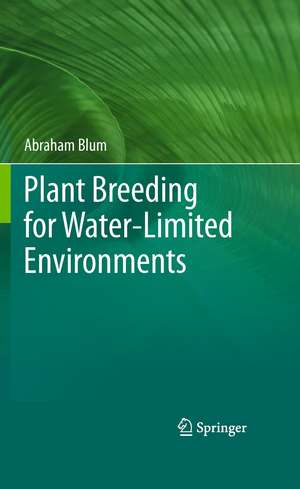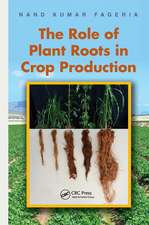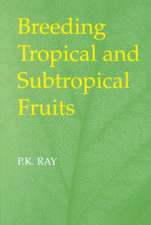Plant Breeding for Water-Limited Environments
Autor Abraham Blumen Limba Engleză Paperback – 8 oct 2014
| Toate formatele și edițiile | Preț | Express |
|---|---|---|
| Paperback (1) | 386.81 lei 6-8 săpt. | |
| Springer – 8 oct 2014 | 386.81 lei 6-8 săpt. | |
| Hardback (1) | 392.37 lei 6-8 săpt. | |
| Springer – 11 noi 2010 | 392.37 lei 6-8 săpt. |
Preț: 386.81 lei
Nou
Puncte Express: 580
Preț estimativ în valută:
74.02€ • 79.15$ • 61.71£
74.02€ • 79.15$ • 61.71£
Carte tipărită la comandă
Livrare economică 18 aprilie-02 mai
Preluare comenzi: 021 569.72.76
Specificații
ISBN-13: 9781489981776
ISBN-10: 1489981772
Pagini: 272
Ilustrații: XIII, 255 p.
Dimensiuni: 155 x 235 x 14 mm
Greutate: 0.39 kg
Ediția:2011
Editura: Springer
Colecția Springer
Locul publicării:New York, NY, United States
ISBN-10: 1489981772
Pagini: 272
Ilustrații: XIII, 255 p.
Dimensiuni: 155 x 235 x 14 mm
Greutate: 0.39 kg
Ediția:2011
Editura: Springer
Colecția Springer
Locul publicării:New York, NY, United States
Public țintă
GraduateCuprins
Preface.- The Moisture Environment.- The Palmer drought index.- The crop moisture index.- The conventions of crop water use.- Plant Water Relations, Plant Stress and Plant Production.- The initiation of plant water deficit.- The soil-plant-atmosphere continuum (SPAC).- The albedo.- The water flux.- Root resistance.- Stem resistance.- Leaf resistance (excluding stomata and cuticle).- Stomatal resistance.- Cuticular resistance.- Plant size and the development of water deficit.- Plant water status and plant stress.- Osmotic adjustment (OA).- Abscisic acid (ABA).- Growth and water deficit.- Root growth under drought stress.- The formation of yield and drought stress.- Drought Resistance and its Improvement.- Genetic gains achieved in plant breeding for drought resistance.- Genomics and breeding for drought resistance.- Gene expression and gene discovery.- Marker-assisted selection (MAS) for drought resistance.- Transgenic plants.- Drought resistance in terms of yield.- Drought resistanceand yield potential: the crossover interaction.- The heritability of yield and drought stress.- QTLs and yield under drought stress.- Drought resistance in terms of physiology.- The disease resistance analogy.- The components of drought resistance.- Water-use efficiency (WUE).- Effective use of water (EUW) and not WUE is the important driver of yield under drought stress.- Summary of plant constitutive traits controlling drought resistance.- The drought resistant ideotype.- The ideotype with respect to drought stress scenarios.- The ideotype with respect to timing of stress.- Phenotyping and Selection.- The managed stress environment.- Site homogeneity.- Experiment station faults.- Controlling the water regime.- Controlling the severity and timing of stress in the field.- Managed drought in protected environments.- Protocols for drought resistance.- Plant growth and productivity.- Plant water status – the expression of dehydration avoidance.- Dehydration tolerance.- High throughput commercial phenotyping service.- Genetic Resources for Drought Resistance.- Cultivated germplasm.- Landraces.- Wild species and crop plant progenitors.- Drought resistant transgenic plants.- Resurrection plants.- Breeding Considerations and Strategies.- Epilogue.
Notă biografică
Abraham Blum is senior scientist retired from The Volcani Center, Agriculture Research Organization, at Bet Dagan, Israel where he headed the dryland wheat and sorghum breeding programs. Throughout his career his main interest was in understanding how plants cope with drought and heat stress and subsequently identify principles and develop methods for the genetic improvement of plant production under drought and heat stress. He authored numerous scientific papers and reviews on the subject as well as a book entitled ‘Plant Breeding for Stress Environments’. Presently he is consulting and teaching, while curating his web site at www.plantstress.com.
Textul de pe ultima copertă
"In general, the book will cater to the needs of plant breeders, researchers/scientists, under-graduate, and graduate students in the field of agriculture. It is a valuable contribution to the current knowledge on breeding for drought tolerance and provides historical background, successes, and potential for the future. We strongly recommend this book to readers as a valuable source of information and a worthwhile addition to one’s book shelf." - Crop Science
Plant breeding for water limited environments has always been a contemporary issue in dryland and rainfed agriculture. However, formal knowledge and methodology in this specific plant breeding domain has been scattered and even lacking, mainly because it is an interdisciplinary endeavor. With the recent looming problem of global warming and water crisis the issue is becoming even more urgent and timely. This book is the first comprehensive and singular treaties on the subject which integrates theory and practice to the extent that it can be used as a plant breeding manual. A main task in writing this book was to sort out the grain from the chaff. In order to achieve it, some threshing was required. The book opens with the essential background on the moisture environment and how it affects plant water status, plant function and plant productivity. It continues from there to explain how plants cope with drought stress by plant constitutive or stress adaptive traits which help to avoid or tolerate dehydration. It concentrates on traits and processes which can be manipulate by plant breeding, separately from those which to date have not yet reached the state of application. Methods of phenotyping and selection for drought resistance are dealt with in detail concentrating again on proven utility, especially under field conditions. Genetic diversity and genetic resources, either practical or potential are discussed and sorted out. Finally, all of the above is funneled into a discussion of some exemplary breeding schemes. The potential of molecular and genomic methods towards breeding for water limited environments are discussed here only where they have been already tested and fully proven as useful at this time. Whereas plant breeding is a science, an engineering project as well as an art, this book is also a reflection of the author’s experience and opinions. It is offered as a sensible and an educational tool to the practitioner, teacher and student in the academia and the industry. Abraham Blum is senior scientist retired from The Volcani Center, Agriculture Research Organization, at Bet Dagan, Israel where he headed the dryland wheat and sorghum breeding programs. Throughout his career his main interest was in understanding how plants cope with drought and heat stress and subsequently identify principles and develop methods for the genetic improvement of plant production under drought and heat stress. He authored numerous scientific papers and reviews on the subject as well as a book entitled ‘Plant Breeding for Stress Environments’. Presently he is consulting and teaching, while curating his web site at www.plantstress.com.
Plant breeding for water limited environments has always been a contemporary issue in dryland and rainfed agriculture. However, formal knowledge and methodology in this specific plant breeding domain has been scattered and even lacking, mainly because it is an interdisciplinary endeavor. With the recent looming problem of global warming and water crisis the issue is becoming even more urgent and timely. This book is the first comprehensive and singular treaties on the subject which integrates theory and practice to the extent that it can be used as a plant breeding manual. A main task in writing this book was to sort out the grain from the chaff. In order to achieve it, some threshing was required. The book opens with the essential background on the moisture environment and how it affects plant water status, plant function and plant productivity. It continues from there to explain how plants cope with drought stress by plant constitutive or stress adaptive traits which help to avoid or tolerate dehydration. It concentrates on traits and processes which can be manipulate by plant breeding, separately from those which to date have not yet reached the state of application. Methods of phenotyping and selection for drought resistance are dealt with in detail concentrating again on proven utility, especially under field conditions. Genetic diversity and genetic resources, either practical or potential are discussed and sorted out. Finally, all of the above is funneled into a discussion of some exemplary breeding schemes. The potential of molecular and genomic methods towards breeding for water limited environments are discussed here only where they have been already tested and fully proven as useful at this time. Whereas plant breeding is a science, an engineering project as well as an art, this book is also a reflection of the author’s experience and opinions. It is offered as a sensible and an educational tool to the practitioner, teacher and student in the academia and the industry. Abraham Blum is senior scientist retired from The Volcani Center, Agriculture Research Organization, at Bet Dagan, Israel where he headed the dryland wheat and sorghum breeding programs. Throughout his career his main interest was in understanding how plants cope with drought and heat stress and subsequently identify principles and develop methods for the genetic improvement of plant production under drought and heat stress. He authored numerous scientific papers and reviews on the subject as well as a book entitled ‘Plant Breeding for Stress Environments’. Presently he is consulting and teaching, while curating his web site at www.plantstress.com.
Caracteristici
A science-based breeder’s manual for water limited environments specifically directed at clearing up the confusion and focusing on what can practically be achieved and how to proceed about it - Integrates the major implications of current knowledge in the different relevant disciplines - No competition to date! Includes supplementary material: sn.pub/extras





